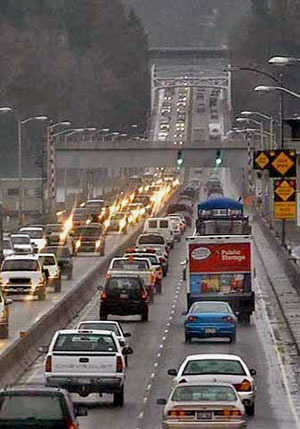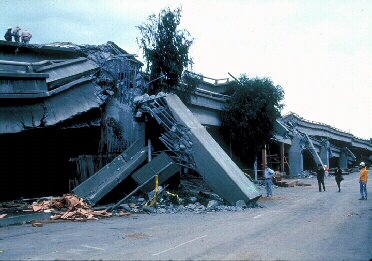NTOC Summer Meeting
September 7, 2007
Washington, DC
Solving the Congestion Problem
Shape Demand
Invest in New Capacity
Operate System at Peak Performance
Bring Supply and Demand into Alignment -- Congestion Pricing
Congestion Pricing – Bringing Supply and Demand into Alignment
Failure to properly price travel on highways is a root cause of congestion.
The price of highway travel (gas taxes, registration fees, etc.) bears little or no relationship to the cost of congestion.
Unlike other public utilities, the public expectation is that the "service" is free or does not change with changes in demand.
Rationing transportation services via pricing is more efficient than rationing by delay.
Congestion Pricing - The Options
Congestion Pricing of Excess HOV Facility Capacity (HOT Lanes)
HOV and HOT Lanes in the U.S.
USDOT's Congestion Initiative: A Six-Point Plan
Relieve Urban Congestion.
Unleash private sector investment resources.
Promote operational and technological improvements.
Establish a "Corridors of the Future" competition.
Target major freight bottlenecks and expand freight policy outreach.
Accelerate major aviation capacity projects and provide a future funding framework.
Urban Partnership Agreements – Congestion Pricing
Congestion Pricing is a key component of the USDOT Congestion Initiative (Relieve Urban Congestion element) - Urban Partnerships.
Integrated "4T" Strategy .
TOLLING (pricing) – Key Element
Direct user charge based on use of facility; varies based on level of congestion
Toll collection via electronic means (no booths)
Transit
Telecommuting/Travel Demand Management
Technology
About $850 million in USDOT Discretionary Funds.
Preliminary Urban Partners
Congestion Pricing - The Progress
Minneapolis – St. Paul Urban Partner
The Big T (Tolling/Pricing)
I-35W between downtown Minneapolis and the southern suburbs.
Existing HOV lanes converted to dynamically-priced HOT lanes (similar to existing MnPASS operation).
Existing HOT lanes extended.
Shoulder lanes dynamically priced.
Minneapolis - St. Paul Urban Partner
Technology
Electronic toll collection
ITS Technology to improve transit services
Arterial and freeway management
Minneapolis - St. Paul Urban Partner
Transit
Establish a Bus Rapid Transit lane into downtown Minneapolis.
Advanced BRT stations and park and ride facilities for the North metro suburbs along the I-35W corridor.
"Transit advantage" bypass lane/ramp.
Contra-flow transit lanes in downtown Minneapolis.
Miami Urban Partner
The Big T (Tolling/Pricing)
21 miles of HOT lanes on I-95 from Fort Lauderdale to downtown Miami.
Raise HOV limit from HOV2 to HOV3+.
Expand 10-lane highway to 12 lanes (by reducing the width of the existing lanes from 12 to 11 feet and using a portion of the shoulder).
Miami Urban Partner
Technology
SunPass electronic toll collection.
Transit
Operate BRT on HOT lanes.
Transit facility improvements.
Telecommuting
Flex-time incentives.
Carpooling and vanpooling programs.
Congestion Pricing - The Progress
Seattle Urban Partner
The Big T (Tolling/Pricing)
Variable pricing on the State Route 520 floating bridge.
King County crossing that currently carries about 160,000 people per day between Seattle and its Eastside suburbs.
Tolls on the existing bridge are intended to help pay for the new bridge.
Seattle Urban Partner
Technology
Electronic toll collection
Real-time multi-modal traveler information
Active traffic management
Transit
Enhance bus service and provide supporting amenities
Regional ferry service
Telecommuting
Carpooling and vanpooling programs
Telecommuting outreach
San Francisco Urban Partner
The Big T (Tolling/Pricing)
Variable pricing on Doyle Drive, the 1.5 mile elevated roadway leading to the Golden Gate Bridge.
Will charge an extra one-way-fee above the $5 toll on the Golden Gate Bridge.
Revenues will help pay to reconstruct the 70-year old Doyle Drive.
San Francisco Urban Partner
Technology
Electronic toll collection.
SFgo Arterial Traffic Management System/Traffic Controller Upgrades.
511 Upgrades.
Creation of Integrated Mobility Accounts.
Dynamic message signs indicating current toll rates.
San Francisco Urban Partner
Transit
Improvements to Regional Ferry Service.
Improved Bus Service, including Bus Rapid Transit.
Telecommuting
Variable pricing of on/off-street parking and city-owned garage spaces in downtown San Francisco.
Telecommuting outreach.
Congestion Pricing - The Progress
New York City Urban Partner
The Big T (Tolling/Pricing)
Will charge drivers $8 and trucks $21 a day to enter or leave Manhattan below 86th Street on weekdays during the workday.
Those who drive only within the congestion zone would pay $4 a day for cars, $5.50 for trucks.
New York City Urban Partner
Technology
Electronic toll collection.
Transit
Bus facilities and other improvements.
Initiation of Bus Rapid Transit.
Regional ferry services.
Congestion Pricing - The Progress
Congestion Pricing – Region Wide Charges
Current Examples
Studies in Oregon and Seattle have tested mileage-based fees and peak-period driving charges.
Nationwide Truck Pricing in Germany, Austria and Switzerland – Automated weight-distance truck tolls across their national highways (Note: Sets the stage for area-wide congestion pricing).
USDOT/FHWA Next Steps
Promote HOV to HOT Conversions through Tailored Technical Assistance
Urban Partners
Provide Direct Support to the Urban Partners
Harness and Share Experiences
Provide General Resource Material - Tailored Workshops and Seminars; Reference Material
Value Pricing Pilot Program Lessons Learned
Model Pricing Legislation
"Making the Case" Outreach and Technical Support
For More Information
Visit
www.fightgridlocknow.gov
www.fhwa.dot.gov/congestion/index.htm
The phrase,'Unsound Transit', was coined by the Wall Street Journal to describe Seattle where,"Light Rail Madness eats billions that could otherwise be devoted to truly efficient transportation technologies." The Puget Sound's traffic congestion is a growing cancer on the region's prosperity. This website, captures news and expert opinion about ways to address the crisis. This is not a blog, but a knowledge base, which collects the best articles and presents them in a searchable format. My goal is to arm residents with knowledge so they can champion fact-based, rather than emotional, solutions.
Transportation
Monday, March 10, 2008
USDOT Presentation on Congestion Relief
The articles are posted solely for educational purposes to raise awareness of transportation issues. I claim no authorship, nor do I profit from this website. Where known, all original authors and/or source publisher have been noted in the post. As this is a knowledge base, rather than a blog, I have reproduced the articles in full to allow for complete reader understanding and allow for comprehensive text searching...see custom google search engine at the top of the page. If you have concerns about the inclusion of a specific article, please email bbdc1@live.com. for a speedy resolution.









